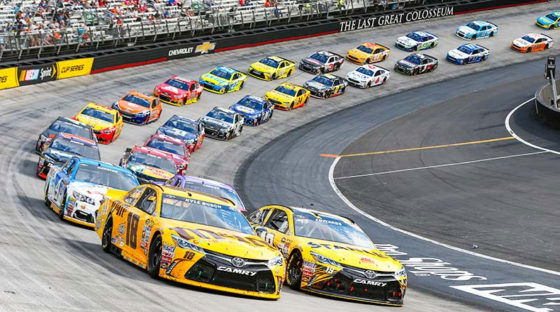“We don’t have any idea. We really don’t.” Brad Keselowski, among others, was left dumbfounded by last Saturday’s Bristol practice. Ever since the Next-Gen car debuted in 2022, short-track racing has taken a hit. Contrary to the thrilling close-quarters racing in the past, drivers frequently find it hard to pass each other. But following the 2024 Spring race in the ‘Thunder Valley’, it looked like Goodyear would have a solution for the short-track racing package.
So the tire partner dove into a year’s worth of efforts to bring out the perfect tires. Cup Series drivers deemed it to be a success on Saturday when the track ate into tires barely after 40 laps. However, Sunday’s Cup race displayed a jaw-dropping difference – leading to frustration in the community.
NASCAR expert defends scapegoat
Well, Goodyear faced waves of fire last year for failing in its experiment. The spring race saw a high tire-wear race with 54 lead changes, leaving experts scratching their heads. Then the tire brand tried to replicate it in the following short-track events like North Wilkesboro and Richmond. During the Fall race in Bristol, there were little to no lead changes as Kyle Larson led for 462 of 500 laps. At that time, fans fired shots at Goodyear for unsuccessfully implementing its option tires. The same fate hangs in the balance for the tire brand after the 2025 Food City 500 race. Larson again dominated, leading 411 laps. However, a NASCAR expert vehemently tries to defend Goodyear.
After all, NASCAR may have found a convenient scapegoat in the tire partner, as short-track racing was already a problem with the Next-Gen car. In a recent episode of ‘The Teardown’, journalist Jeff Gluck tore apart the sport for deflecting the blame from the real problem. “Everybody kind of got lulled into this thing like, ‘Okay, yeah you know what? Let’s put it on Goodyear. Because this is where the rubber meets the road literally. And if Goodyear can fix this problem for us, let’s focus on that.’ The whole conversation changed from what can we do on the car, what can we do aero-wise, how can we make this car…to race better on short tracks? And the answer is apparently, you can’t.” Overall, he passed his verdict: “This was absolutely pathetic.”
BRISTOL, TENNESSEE – SEPTEMBER 18: Kyle Larson, driver of the #5 Valvoline Chevrolet, waves to fans during pre-race ceremonies prior to the NASCAR Cup Series Bass Pro Shops Night Race at Bristol Motor Speedway on September 18, 2021 in Bristol, Tennessee. (Photo by Logan Riely/Getty Images)
What bugged Jeff Gluck and others more was the thoroughly unpredictable situation. While Saturday’s practice yielded high wear, drivers realized 50 laps into the main race that they would go the entire 125-lap first stage on the same set of Goodyears. Gluck continued with his rant: “The tires are so sensitive with the heavy car and the wide tire that a few degrees of temperature make a completely different race – threw everybody off. The crew chiefs we talked to this morning thinking, ‘Oh, it’s going to be a high-wear race’…Goodyear and NASCAR gave them an extra set of tires…The drivers, they started the race slowly, puttering around…But then they realized…the track wasn’t taking rubber. The leaders were staying out to avoid pit stops. All of this was unacceptable for a NASCAR short track race.”
The final race left many teams in a mess with their strategies. However, the leaders were right in place as they prepared flexibly.
Adjusting to changes on a quick footing
NASCAR crew chiefs were left scratching their heads on Saturday. In a matter of 28 hours, they had to overhaul their racing strategies for the Food City 500 race. Engineers agonized overnight about different strategies and car setups that could better support the tire wear. But they were even more wildly surprised when the tires did not react at all on Sunday – apparently due to warmer conditions. James Small, crew chief for the No. 19 Joe Gibbs Racing car, joked: “If we had all bet our houses on it like we said we would, we would all be homeless based on our practice yesterday.” Despite the shuffle in strategy, the good racers persisted nonetheless. A contingent of JGR drivers landed in the top five – Denny Hamlin, Ty Gibbs, and Chase Briscoe. But more importantly, a Hendrick Motorsports star beat all of them.
Kyle Larson finished second in last year’s tire management race. The No. 5 HMS crew chief, Cliff Daniels, confessed that they prepared meticulously for both scenarios – both high tire-wear and long green-flag runs. “Our learning experience from last year when it was the ‘chaos’ race was a well-balanced car was still going to give you the best potential to manage it on either side. So our focus yesterday in practice, even though we went really fast for what our run was and wore out our tires really quickly, it gave us a great read on the balance of the car and a couple of little things we could take into today, knowing that, either way the race could potentially go, we’re just trying to set ourselves up for the best opportunity for longevity, for pace, for Kyle being able to manage the runs with the tire degradation in mind.”
The Goodyear tire situation certainly has been a bizarre situation in Bristol. Yet as Jeff Gluck pointed out, it must be more than just the tires.
The post Insider Goes on Ballistic Rant as NASCAR Pushes Blame on Goodyear Over “Pathetic” Bristol Race appeared first on EssentiallySports.
